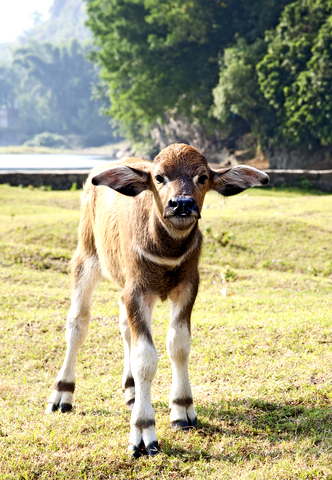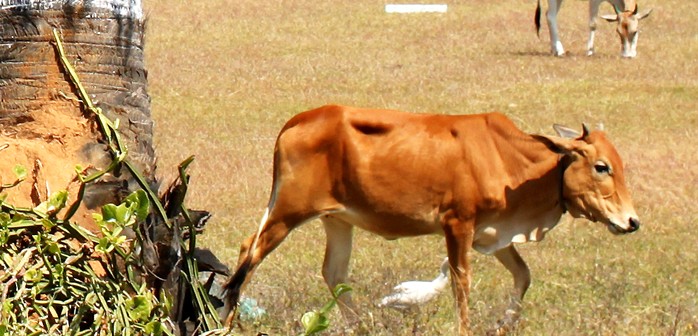To read part one first, click here.
Meanwhile, Gauri Maulekhi, of HSI and PFA, appealed to the Supreme Court of India, which then issued a directive to close the India-Nepal border to any transport of animals into Nepal during the weeks preceding the festival.
Since most of the animals to be sacrificed came from India, closing the border had a momentous effect.
Large numbers of volunteers from Indian animal welfare groups arrived to assist the Border Patrol in spotting people trying to take animals to Nepal. They spoke with farmers and other animal transporters and, if they did not turn back, the volunteers followed up with the Border Patrol to make sure they were sent back.
Dawn Williams and his team from Blue Cross of India played a leading role in tracking down those attempting to smuggle animals into Nepal. A former commando, Dawn Williams rescues animals daily, often risking his life going down dangerous wells to pull out cows, dogs, cats, or other animals. Animal People contributed a generous grant to support this highly successful effort along the Indian/Nepalese border.
Jayasimha Nuggehalli and Alokparna Sengupta of HSI – India and many other volunteers were also there. All these courageous animal people, along with a great many others, on both sides of the border, worked long days and nights in hazardous, primitive conditions.
 The volunteers from the various groups rescued around 2,500 animals and sent them to shelters. Many thousands of animal owners and transporters were turned around, taking their animals back home with them.
The volunteers from the various groups rescued around 2,500 animals and sent them to shelters. Many thousands of animal owners and transporters were turned around, taking their animals back home with them.
Also in the days leading up to the event, in Nepal, Uttam Dahal of Nepal Animal Welfare and Research Centre approached Nepal’s Supreme Court, which issued a directive that all Nepalese laws were to be enforced by the police and adhered to by all local and national authorities and individuals, including the Nepal Animal Health and Livestock Services Act, the Nepal Animal Slaughterhouse and Meat Inspection Act, and the Environment Protection Act. In other words, the Court ruled that barbaric slaughter by machete in unsanitary conditions would not be allowed. This re-enforced the stance of animal activists that the Gadhimai sacrifice was illegal.
Jayasimha Nuggehalli and Alokparna Sengupta in a journal described the difficult and dangerous circumstances of their work along the border. At one point they stopped a transport truck full of buffaloes – this nearly led to their arrest by the Nepalese police who stopped them repeatedly throughout the rest of the day. They wrote sad descriptions of animals being led along to the sacrifice. As they made their way towards the temple, they encountered a horrendous scene of hundreds of thousands of people camped out in open fields and then, in the days following, the mass killings of animals near the temple.
They and the many other volunteers rescued many animals. Sadly, some animals did get through and thousands of animals were slaughtered – however, the total was at least 70% fewer animals than the half a million slaughtered in 2009.
In the end, the festival itself was a failure, so much so that the Chinese company who had contracted to buy the remains of the poor slaughtered animals canceled their contract – there were just not enough animals available. The future was already looking bleak for the next Gadhimai festival in 2019.
 Inside the temple, for several hours, as multitudes of people approached the head priest, Mangal Chaudry, to seek his blessings, Dr. Nanditha Krishna, who had earlier made his acquaintance at Jaipur, had been invited to sit beside him. Dr. Nanditha Krishna has an unmatched gift for communicating about innocent animals – in a way that is both non-judgmental and unflinchingly direct – a clear voice of truth. In numerous situations behind the scenes, without fanfare, her words, whether to government leaders or to rural village women have helped to turn the tide on one animal issue after another. There is no doubt that they had an effect in this case.
Inside the temple, for several hours, as multitudes of people approached the head priest, Mangal Chaudry, to seek his blessings, Dr. Nanditha Krishna, who had earlier made his acquaintance at Jaipur, had been invited to sit beside him. Dr. Nanditha Krishna has an unmatched gift for communicating about innocent animals – in a way that is both non-judgmental and unflinchingly direct – a clear voice of truth. In numerous situations behind the scenes, without fanfare, her words, whether to government leaders or to rural village women have helped to turn the tide on one animal issue after another. There is no doubt that they had an effect in this case.
Manoj Gautam, President and Founder of AWNN, in Nepal, also spoke at length with the head priest and held a number of meetings with the temple committee.
The conditions around the festival were entirely horrible for all those who traveled there to help the animals – the brutality and hatred, the filth and dirt, the smells, the sights, the sounds, all were a nightmare – from the travel on dangerous, rugged roads to the atmosphere of cruelty and the immense suffering of the animals. All those who went to help are heroes, and many thanks are due also to all those who supported them in India, in Nepal, and around the world.
In the end, the bloodsport that was the Gadhimai sacrifice could not stand up to the combined force of those working on behalf of the animals, and, at last, the temple sacrifice was revealed to all as what it was – a horror, a disaster, and finally also an economic failure.
With the announcement, on July 28, 2015, by Motilal Prasad Gadhimai Temple Trust Secretary and Ram Chandra Shah, Trust Chairman, the Gadhimai animal sacrifice finally came to an end.
Because one could not forget the suffering of so many animals, the ending of the sacrifice was not a joyful victory, but it was a decisive one.
In the words of Dr. Chinny Krishna, Chairman Emeritus of Blue Cross of India, “A tipping point had been reached, with the negative world-wide publicity of the senseless killing, the lower than expected numbers of those killed, and the Supreme Court’s rulings which would have ensured even smaller numbers of animals in 2019.”
An entrenched, blood-thirsty spectacle, which it seemed might never end, had been stopped by the will, the courage, and the dedication of the many who set aside their own wellbeing and comfort, and who never gave up in their fight to save hundreds of thousands, and over the years what would have become millions, of innocent animals.
© Sharon St Joan, 2015
Top photo: © Sharon St Joan
Second photo: © Erinpackardphotography / Dreamstime.com
Third photo: © Aleksandr Noskov / Dreamstime.com





